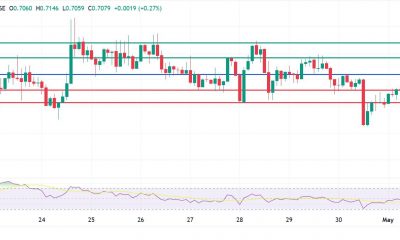

others
US Dollar weakens on higher Jobless Claims – Crypto News
- The DXY Index shows losses, trading near the 103.05 area.
- Weekly Jobless Claims came in higher than expected.
- Markets still digesting Wednesday’s Fed decision and Powell’s words.
The US Dollar (USD) is currently trading at 103.05, with a declining trend, largely triggered by the release of soft labor market data on Thursday that outshadowed strong ISM PMIs figures. Markets are still digesting Federal Reserve (Fed) chair Jerome Powell’s words from Wednesday, which helped the index jump toward 103.80.
Fed Chair Powell reinforced the idea that a rate cut in March is unlikely despite ongoing market speculation. Nevertheless, he noted rate adjustments remain primarily data-dependent, with upcoming jobs data setting the pace of the US Dollar and expectations for the short term.
Daily Digest Market Movers: US Dollar declines following weak labor market figures
- The ISM Manufacturing PMI for January came in at 49.1, lower than the consensus estimate of 47 but slightly higher than the previous figure of 47.1.
- The initial Jobless Claims for the week ending in January 27 reported by US Department of Labor are at 224K, higher than the consensus forecast of 212K and the previous figure of 215K.
- Investors are keenly awaiting the January Nonfarm Payrolls report due on Friday to continue placing their bets on the next Fed decisions.
- As for now, markets are seeing the easing cycle starting in May, but the odds of a cut in March are still high around 40%, according to the CME FedWatch Tool.
- In case Friday’s labor market figures come in weaker than expected, the dovish bets on the Fed may rise, applying further pressure on the USD.
Technical Analysis: DXY bears step in to push the index below 200-day SMA
The indicators on the daily chart are reflecting a tentative dominance of selling momentum in the short term. The Relative Strength Index (RSI), albeit on a negative slope, is holding in positive territory, reflecting dwindling buying momentum. This is further supported by the Moving Average Convergence Divergence (MACD) indicator, which showcases decreasing green bars, an indication that the selling pressure is slowly gaining traction.
Furthermore, the positioning of the index concerning its 20,100 and 200 Simple Moving Averages (SMAs) points to a bullish hold in the broader context. The pair still holds above the 20-day SMA, signaling that the bears have failed to command complete control in the short term. However, the DXY’s positioning below the 100 and 200-day SMAs suggests more dominant selling momentum in the longer-term.
Employment FAQs
Labor market conditions are a key element to assess the health of an economy and thus a key driver for currency valuation. High employment, or low unemployment, has positive implications for consumer spending and thus economic growth, boosting the value of the local currency. Moreover, a very tight labor market – a situation in which there is a shortage of workers to fill open positions – can also have implications on inflation levels and thus monetary policy as low labor supply and high demand leads to higher wages.
The pace at which salaries are growing in an economy is key for policymakers. High wage growth means that households have more money to spend, usually leading to price increases in consumer goods. In contrast to more volatile sources of inflation such as energy prices, wage growth is seen as a key component of underlying and persisting inflation as salary increases are unlikely to be undone. Central banks around the world pay close attention to wage growth data when deciding on monetary policy.
The weight that each central bank assigns to labor market conditions depends on its objectives. Some central banks explicitly have mandates related to the labor market beyond controlling inflation levels. The US Federal Reserve (Fed), for example, has the dual mandate of promoting maximum employment and stable prices. Meanwhile, the European Central Bank’s (ECB) sole mandate is to keep inflation under control. Still, and despite whatever mandates they have, labor market conditions are an important factor for policymakers given its significance as a gauge of the health of the economy and their direct relationship to inflation.
-

 Technology1 week ago
Technology1 week agoOpenAI explains ‘THIS’ is why it reversed GPT-4o update amid sycophantic behavior concerns – Crypto News
-

 Cryptocurrency1 week ago
Cryptocurrency1 week agoCardano Price Finds $0.700 Support to Strengthen Upward Traction – Crypto News
-
Business1 week ago
Here’s What to Expect From BTC, ETH, XRP & SOL as S&P500 Secretly Mirrors 1998 Cycle – Crypto News
-

 Cryptocurrency1 week ago
Cryptocurrency1 week agoRipple and SEC inch closer to resolution as April 16 looms – Crypto News
-

 Blockchain1 week ago
Blockchain1 week agoPeter Brandt Predicts When Bitcoin Price Might Reach $150,000, Technical Signals Show Where Market Is At – Crypto News
-

 others1 week ago
others1 week agoUS State Paying $2,000,000,000 To Residents – No Strings Attached – in First-Ever ‘Inflation Rebate’ Program – Crypto News
-

 Cryptocurrency1 week ago
Cryptocurrency1 week agoXRP jumps 30% on Ripple news – Crypto News
-

 Cryptocurrency1 week ago
Cryptocurrency1 week ago$240M outflows amid tariff uncertainty – Crypto News
-

 others1 week ago
others1 week agoDow Jones soars 600 points as NFP data calms recession fears, weekly gains top 3% – Crypto News
-

 Cryptocurrency1 week ago
Cryptocurrency1 week agoFriday Charts: Will natural intelligence keep us employed? – Crypto News
-

 Metaverse1 week ago
Metaverse1 week agoAI Tool of the Week | How to run a strategy pre-mortem with ChatGPT’s o3 model – Crypto News
-

 Cryptocurrency1 week ago
Cryptocurrency1 week agoAnalysts Remain Bullish on Strategy’s Bitcoin Buying Plans – Crypto News
-

 others1 week ago
others1 week agoBullish momentum, buyers don’t give up – Crypto News
-
Technology1 week ago
US Senators Withdraw Support For GENIUS Act: Here’s Why – Crypto News
-
others1 week ago
Singapore Retail Sales (YoY) climbed from previous -3.6% to 1.1% in March – Crypto News
-

 Blockchain4 days ago
Blockchain4 days agoBitcoin Surpasses $100K Mark Amid New Trade Deal – Crypto News
-
Technology1 week ago
Predicting Ethereum Price Target as ETH Mirrors Bitcoin’s Rally that Pushed it to $100k – Crypto News
-
Technology1 week ago
TRUMP Token as Reserve Asset? US Logistics Firm Freight Technologies To Hold TRUMP – Crypto News
-
Technology1 week ago
Bitcoin Price Eyes $100k as Saylor Buys $1.42B BTC — Fed Decision Looms – Crypto News
-

 Cryptocurrency1 week ago
Cryptocurrency1 week agoStatus (SNT) price up after 35% dev activity rise – Crypto News
-
others7 days ago
Breaking: VanEck Files S1 Form With US SEC To Launch BNB ETF – Crypto News
-
others7 days ago
Breaking: VanEck Files S1 Form With US SEC To Launch BNB ETF – Crypto News
-
Technology7 days ago
ECB Kicks Off Digital Euro Testing with 70 Firms Across Europe – Crypto News
-

 Cryptocurrency7 days ago
Cryptocurrency7 days agoWill Bitcoin Fall Below $90K as Ethereum and XRP Lose Momentum? – Crypto News
-

 Business6 days ago
Business6 days agoRite Aid Files for Bankruptcy, Job Cuts Expected – Crypto News
-

 Blockchain2 days ago
Blockchain2 days agoBitcoin yet to hit $150K because outsiders are ghosting — Michael Saylor – Crypto News
-
Business1 week ago
No New RLUSD Minted This Week — What’s Behind the Pause? – Crypto News
-

 Blockchain1 week ago
Blockchain1 week agoDogecoin Eyes $1.80 In Summer Rally, Predicts Crypto Analyst – Crypto News
-

 Cryptocurrency1 week ago
Cryptocurrency1 week agoUS Treasury Predicts Stablecoin Market Could Surge to $2 Trillion by 2028 – Crypto News
-

 others1 week ago
others1 week agoEuro steadies near 1.5600 as bulls hold longer-term edge – Crypto News
-
Business1 week ago
3 Altcoins to Buy If Donald Trump’s Trade Negotiations with China Fail – Crypto News
-
Technology1 week ago
Warren Buffett To Step Down, Will Berkshire Hathaway Finally Embrace Bitcoin? – Crypto News
-
Business1 week ago
ETH Traders Hold $20.8 Billion Positions as Vitalik Buterin Plan to Fix Ethereum in 5 Years – Crypto News
-

 Metaverse1 week ago
Metaverse1 week agoWarren Buffett announces retirement from Berkshire Hathaway — these are his smartest bets, as per Perplexity AI – Crypto News
-

 others1 week ago
others1 week agoUSD/JPY retreats from highs as Dollar weakens and Japan signals tariff pushback – Crypto News
-
others1 week ago
Ripple Whale Moves $64M As Analyst Predicts XRP Price Bullish Breakout – Crypto News
-

 Cryptocurrency1 week ago
Cryptocurrency1 week agoWhat Does it Mean for Ripple’s Price? – Crypto News
-

 Cryptocurrency1 week ago
Cryptocurrency1 week agoNext Telegram Gaming Boom Will Come From Reinventing Classics: ‘Notcoin’ Founders – Crypto News
-
Technology1 week ago
Ethereum Price Recovery Soon? Key Factors Point To ETH Bull Rally Ahead – Crypto News
-

 Blockchain1 week ago
Blockchain1 week agoBitcoin At $100K? $3 Billion In Shorts Are On The Line – Crypto News
-

 Cryptocurrency1 week ago
Cryptocurrency1 week agoEthereum Price Prediction 2025, 2027, and 2030: Will ETH Reach $10,000 – Crypto News
-
Business1 week ago
Here is Dogecoin Price If DOGE ETF Gets 30% to 50% of Bitcoin ETF Inflows – Crypto News
-

 Metaverse1 week ago
Metaverse1 week agoChatGPT overtakes Elon Musk’s X in monthly traffic after viral Ghibli-style image trend – Crypto News
-

 others1 week ago
others1 week agoAUD/JPY trades soft near 93.50 as global trade uncertainties increase safe-haven demand – Crypto News
-

 Metaverse7 days ago
Metaverse7 days agoMilken Conference: Elon Musk asks US govt to use AI to replace functions of some workers – Crypto News
-

 Technology7 days ago
Technology7 days agoOpenAI dials back conversion plan, nonprofit to retain control – Crypto News
-

 others6 days ago
others6 days agoRetail Traders Embracing ‘Gamble’ Mindset As Memecoin Discussions Hit Highest Level This Year, Warns Santiment – Crypto News
-

 Blockchain6 days ago
Blockchain6 days agoIs Another Drop on the Horizon? – Crypto News
-

 Blockchain6 days ago
Blockchain6 days agoA Correction To This Level Could Come First – Crypto News
-

 Blockchain6 days ago
Blockchain6 days ago$25 Million Pledge From Ripple Set To Benefit Teachers And Students Across The US – Crypto News












